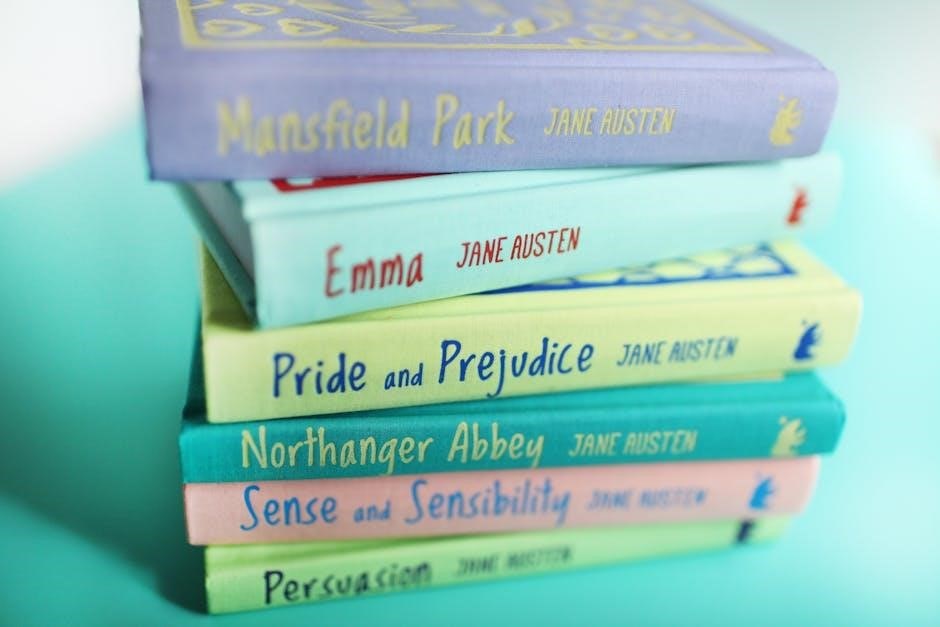The Shining is a chilling 1977 horror novel by Stephen King, exploring isolation, madness, and supernatural forces through the Torrance family’s eerie experience at the Overlook Hotel.
Overview of the Story and Its Significance
The Shining, Stephen King’s third novel, follows the Torrance family as they confront supernatural forces at the isolated Overlook Hotel. Jack, a writer battling alcoholism, becomes the hotel’s winter caretaker, hoping to rebuild his life. However, the hotel’s dark history and haunting energies gradually unravel his sanity, threatening his wife Wendy and their son Danny, who possesses psychic abilities. The novel masterfully blends psychological horror with supernatural elements, exploring themes of isolation, madness, and the destructive power of unchecked emotions. Its enduring popularity lies in its ability to evoke fear through both the unseen and the deeply human, cementing its place as a horror classic.
Why “The Shining” Remains a Horror Classic
The Shining endures as a horror masterpiece due to its masterful blend of psychological tension and supernatural terror. King’s vivid portrayal of isolation and madness, coupled with the eerie atmosphere of the Overlook Hotel, captivates readers. The novel’s exploration of themes such as alcoholism, family dynamics, and the breakdown of sanity resonates deeply. Its ability to evoke fear through both the unseen and the deeply human ensures its timeless appeal. Adapted into iconic film and culture, it remains a benchmark for horror, proving King’s genius in crafting stories that haunt and unsettle, solidifying its legacy as a genre-defining classic.
Background and Inspiration for “The Shining”
Stephen King drew inspiration from personal struggles with alcoholism and a stay at the isolated Stanley Hotel, which influenced the eerie Overlook Hotel setting.
Stephen King’s Personal Experiences and Influences
Stephen King’s personal struggles with alcoholism deeply influenced The Shining, as he drew parallels between his own addiction and Jack Torrance’s descent into madness. King’s stay at the Stanley Hotel in Colorado inspired the eerie atmosphere of the Overlook Hotel, blending isolation with supernatural elements. His exploration of family dynamics and psychological breakdowns added layers of tension, making the novel a gripping exploration of human vulnerability. These personal and environmental influences crafted a story that remains a cornerstone of horror literature.
The Real-Life Hotel That Inspired the Overlook
The Overlook Hotel was inspired by the Stanley Hotel in Colorado, a historic location with a haunting atmosphere. Stephen King stayed there in 1973, just before the hotel closed for the season, sparking his imagination. The Stanley’s grandeur, isolation, and eerie ambiance influenced King’s depiction of the Overlook. Stories of paranormal activity and the hotel’s dark past further shaped the novel’s supernatural elements. King’s experience at the Stanley transformed into the Overlook’s terrifying presence, making it a central character in the story.
King’s Approach to Crafting Horror and Suspense
Stephen King masterfully crafts horror and suspense in The Shining by blending psychological tension with supernatural elements. He isolates the Torrance family in a remote, eerie setting, amplifying their vulnerabilities. King’s slow-building tension creates unease, while the hotel’s dark past and haunting presence add layers of fear. His ability to craft relatable characters and explore their inner turmoil makes the horror deeply personal. By juxtaposing the supernatural with real-life struggles, King ensures the novel is both terrifying and emotionally resonant, leaving readers on edge and invested in the family’s fate.
Publication and Reception of “The Shining”
The Shining, published in 1977, became Stephen King’s first hardcover bestseller, solidifying his reputation as a master of horror. Its chilling narrative and psychological depth captivated readers, making it a landmark in the genre;
Publication Details and Initial Reviews
The Shining was published in 1977 by Doubleday, marking Stephen King’s first hardcover bestseller. Initial reviews praised its chilling narrative and psychological depth, though some critics found its pacing slow. The novel’s exploration of isolation and madness resonated with readers, solidifying King’s reputation as a horror master. Its success led to widespread acclaim, making it a cornerstone of modern horror literature.
Commercial Success and Cultural Impact
The Shining became a massive commercial success, propelling Stephen King to newfound fame. Its haunting narrative resonated with readers, making it a bestseller and cementing its place in horror literature. The novel’s cultural impact was amplified by Stanley Kubrick’s iconic 1980 film adaptation, which introduced the story to a wider audience. The book’s themes of isolation and madness continue to influence popular culture, with references in media and entertainment; Its enduring popularity has made it a staple in horror, ensuring its relevance for generations of readers and inspiring countless adaptations and interpretations.
Comparisons to Other Works by Stephen King
While The Shining stands as a unique gem in Stephen King’s bibliography, it shares thematic ties with his other works, such as isolation and psychological unraveling. Like Carrie and Misery, it delves into the darker corners of the human psyche, yet its supernatural elements and atmospheric setting set it apart. The novel’s focus on family dynamics and the blurred lines between reality and horror are reminiscent of King’s signature style. However, its gothic undertones and the Overlook Hotel’s haunting presence make it a standout piece, showcasing King’s versatility in crafting terrifying narratives that linger long after the final page.

The Plot of “The Shining”
The Shining follows Jack Torrance, his wife Wendy, and their son Danny, who move into the isolated Overlook Hotel. Supernatural forces and dark secrets unfold, descending into horror.
The Torrance Family and Their Struggles
The Torrance family—Jack, Wendy, and their son Danny—face profound internal and external conflicts. Jack, a writer battling alcoholism, seeks redemption but spirals into madness. Wendy, protective of Danny, struggles to maintain hope amidst isolation. Danny, a child with psychic abilities, grapples with terrifying visions of the hotel’s dark past and his father’s deterioration. Their strained relationships and individual struggles are exacerbated by the Overlook’s haunting presence, creating a descent into chaos and horror.
The Isolated Setting of the Overlook Hotel
Nestled in the remote Colorado mountains, the Overlook Hotel serves as a central character in the novel, its isolation amplifying the horror. The hotel’s grandeur contrasts with its eerie atmosphere, as it becomes a prison during the harsh winter. The Torrance family’s isolation from civilization intensifies their internal conflicts and exposes them to the hotel’s dark supernatural forces. The Overlook’s labyrinthine structure and haunted past create a claustrophobic environment, where the boundaries between reality and madness blur. Its seclusion heightens the sense of dread, making it a pivotal element in the unfolding terror.
The Supernatural Forces at Play
The Overlook Hotel is a hub of malevolent supernatural energy, manifesting as ghostly apparitions, unexplained events, and psychological manipulation. These forces prey on the vulnerabilities of the Torrance family, particularly Jack’s alcoholism and Danny’s psychic abilities. The hotel’s dark history and tragic past fuel its haunting, creating an environment where the living are not alone. The supernatural elements escalate tensions, driving characters to madness and violence. This unseen evil is a central driver of the horror, making the Overlook a character in itself that exerts a sinister influence on all who enter.

Major Themes in “The Shining”
The Shining explores the destructive nature of alcoholism, psychological effects of isolation, and the dynamics of family relationships, weaving them into a chilling narrative of horror and despair.
The Destructive Nature of Alcoholism
Jack Torrance’s struggle with alcoholism is a central theme in The Shining, illustrating how addiction can destroy lives and relationships. His dependence on alcohol, coupled with his inner demons, fuels his descent into madness. The novel portrays alcoholism as a destructive force that erodes Jack’s ability to be a loving father and husband, ultimately leading to terrifying consequences. King’s depiction of Jack’s addiction serves as a cautionary tale, highlighting the devastating impact of unchecked substance abuse on individuals and families, while also deepening the novel’s horror and psychological complexity.
The Psychological Effects of Isolation
The Overlook Hotel’s remote location and eerie atmosphere amplify the psychological effects of isolation on the Torrance family. Jack’s isolation intensifies his inner instability and alcoholism, leading to madness. Wendy and Danny, trapped in the hotel, experience escalating fear and paranoia. The novel highlights how isolation can exacerbate mental vulnerabilities, creating a breeding ground for terror. King masterfully explores how solitude disrupts familial bonds and accelerates psychological breakdowns, making the characters—and readers—feel trapped and vulnerable. This theme underscores the horror of being disconnected from humanity and the devastating consequences of prolonged isolation.
The Dynamics of Family Relationships
The Shining delves into the complex dynamics of the Torrance family, revealing strained relationships and emotional turmoil. Jack’s struggle with alcoholism and anger creates tension with Wendy, while Danny’s psychic abilities isolate him further. The novel portrays a family on the brink, with each member facing personal demons. King masterfully illustrates how internal conflicts and external pressures can fracture familial bonds. The Overlook Hotel’s haunting presence exacerbates these dynamics, transforming a troubled family into a powder keg of emotions. This exploration of family dysfunction adds depth to the horror, making the Torrances’ fate both tragic and terrifying. Their unraveling is a poignant commentary on the fragility of human relationships.

The Overlook Hotel as a Character
The Overlook Hotel emerges as a character itself, with its dark history, haunting presence, and supernatural influence shaping the Torrances’ fate and the novel’s chilling atmosphere.
Its Dark History and Haunting Presence
The Overlook Hotel’s dark history is steeped in tragedy and unexplained occurrences, creating an eerie atmosphere that permeates every corner. Its past, marked by mysterious disappearances and untimely deaths, sets the stage for the supernatural events that unfold. The hotel’s haunting presence is palpable, as if it were alive, exerting a malevolent influence over its inhabitants. This oppressive energy is central to the horror, affecting the Torrance family deeply and drawing out their deepest fears and vulnerabilities. The Overlook’s history and presence are key elements that drive the story’s chilling narrative forward, making it a central character in the novel’s terrifying unfolding.
Symbolism of the Hotel’s Architecture
The Overlook Hotel’s architecture symbolizes the labyrinthine nature of human psychology, with its endless corridors and hidden rooms mirroring the characters’ inner turmoil. Its grandeur and isolation evoke a sense of entrapment, reflecting the Torrance family’s growing desperation. The hotel’s imposing structure, with its maze-like design, serves as a physical manifestation of the characters’ mental unraveling. The ever-shifting layout and eerie spaces symbolize the unpredictability of madness and the supernatural forces at play. Room 237, in particular, becomes a focal point of dread, embodying the dark secrets and tragedies buried within the hotel’s walls, amplifying the novel’s haunting atmosphere and themes of isolation and despair.
The Hotel’s Influence on the Characters
The Overlook Hotel exerts a malign influence over its inhabitants, amplifying their deepest fears and vulnerabilities. Its dark history and supernatural presence manipulate the characters, particularly Jack Torrance, whose sanity unravels under its oppressive atmosphere. The hotel’s isolation and eerie grandeur heighten the family’s psychological strain, pushing them toward despair and violence. Danny, with his psychic abilities, is acutely affected, sensing the hotel’s malevolent energy. Meanwhile, Wendy and Danny become increasingly entangled in a desperate fight for survival as the hotel’s grip tightens, symbolizing the destructive power of isolation and the supernatural forces that haunt its corridors.
Film Adaptations of “The Shining”
Stanley Kubrick’s iconic 1980 adaptation of The Shining stars Jack Nicholson, while Mick Garris’s 1997 miniseries offers a more faithful take. Both adaptations captivate audiences with chilling storytelling.
Stanley Kubrick’s Iconic 1980 Film
Stanley Kubrick’s The Shining is a masterful adaptation of Stephen King’s novel, starring Jack Nicholson as Jack Torrance. The film is renowned for its meticulous direction, eerie atmosphere, and psychological depth. Kubrick’s vision diverges from the book, focusing more on isolation and madness. The iconic scenes, such as the “Here’s Johnny!” moment, have become cultural landmarks. Despite initial mixed reviews, the film has grown into a horror classic, celebrated for its visual brilliance and unsettling tone. It remains a testament to Kubrick’s innovative storytelling and his ability to evoke fear through silence and imagery.
Differences Between the Book and the Film
Stephen King’s novel and Stanley Kubrick’s film adaptation of The Shining differ significantly. King’s book focuses on supernatural forces and the hotel’s dark past, while Kubrick’s film emphasizes psychological horror and visual storytelling. The novel ends with the hotel’s destruction, whereas the film concludes with Jack Torrance frozen in the hedge maze. Jack’s character is more sympathetic in the book, with a gradual descent into madness, while Jack Nicholson’s portrayal is more overtly unstable. Wendy’s role is stronger in the novel, showcasing her resilience. The film omits key supernatural elements, creating a more ambiguous narrative. These differences highlight distinct interpretations of the story.
Reception and Legacy of the Film
Stanley Kubrick’s adaptation of The Shining received mixed reviews upon its 1980 release but has since become a horror classic. Its eerie atmosphere and meticulous direction solidified its place in cinema history. Kubrick’s visual storytelling and exploration of psychological horror have influenced countless filmmakers. The film’s iconic scenes and themes of isolation and madness continue to captivate audiences. Despite differences from the novel, Kubrick’s vision remains a landmark in horror, ensuring its enduring legacy.

Legacy and Impact of “The Shining”
The Shining remains a cornerstone of horror literature, influencing countless works and cementing its place in popular culture through its exploration of isolation, madness, and the supernatural.
Its Place in Horror Literature
The Shining is widely regarded as a masterpiece of modern horror, seamlessly blending psychological terror with supernatural elements. Its exploration of isolation, madness, and the darker aspects of human nature has redefined the genre. King’s ability to craft relatable characters and build tension through atmospheric settings has made the novel a benchmark for horror writers. The Overlook Hotel’s haunting presence and the Torrance family’s descent into chaos continue to captivate readers, solidifying The Shining as a timeless classic in horror literature. Its influence is evident in both literary works and popular culture, ensuring its enduring legacy.
Influence on Popular Culture
The Shining has left an indelible mark on popular culture, inspiring countless references in film, TV, and media. Stanley Kubrick’s 1980 adaptation, particularly its iconic scenes, has become synonymous with horror. The novel’s eerie atmosphere and unforgettable visuals, such as the Overlook Hotel’s labyrinthine corridors, have influenced filmmakers and writers. Phrases like “Here’s Johnny” and the hotel’s haunting image are deeply ingrained in pop culture. The story’s themes of isolation and madness continue to inspire new adaptations and parodies, cementing its status as a cultural touchstone. Its influence extends beyond literature, making it a timeless horror icon.
Continued Relevance in Modern Times
The Shining remains a timeless tale, resonating with modern audiences through its exploration of universal themes such as isolation, mental health, and family dynamics. The novel’s eerie setting and psychological depth continue to captivate readers, while its themes of addiction and personal breakdown mirror contemporary struggles. The rise of digital media has introduced the story to new generations, with e-book formats like PDF making it easily accessible. Its enduring popularity is a testament to King’s ability to weave horror with human vulnerability, ensuring its relevance in today’s fast-paced world, where isolation and mental health are pressing concerns.
The Sequel: “Doctor Sleep”
Continuing Danny Torrance’s Story
Doctor Sleep, published in 2013, follows Danny Torrance as an adult, grappling with his psychic powers and the lingering darkness of the Overlook Hotel, exploring themes of trauma and redemption. The novel bridges the past and present, offering a fresh perspective on the horrors introduced in The Shining. King’s sequel delves into Danny’s struggles with addiction and his efforts to protect others from supernatural forces, while also addressing unanswered questions from the original story. The book has been well-received for its emotional depth and connection to the first novel, further solidifying the legacy of The Shining series. In 2019, a film adaptation of Doctor Sleep was released, starring Ewan McGregor as Danny, bringing the story to a new generation of fans. The novel’s exploration of psychological trauma and the power of redemption continues to resonate with readers, ensuring its place in modern horror literature. Additionally, the availability of Doctor Sleep in PDF format has made it accessible to a broader audience, allowing fans of The Shining to seamlessly continue Danny’s journey in digital formats. The book serves as a testament to Stephen King’s ability to craft stories that endure long after the final page is turned.
Doctor Sleep follows Danny Torrance, now an adult, as he confronts the lingering trauma of his childhood at the Overlook Hotel. Struggling with his psychic powers, Danny faces personal demons and supernatural threats. The novel explores his journey toward redemption and healing, delving into themes of addiction and the power of facing one’s past. By bridging the gap between The Shining and the present, King offers a haunting yet hopeful continuation of Danny’s story, revealing how the horrors of the Overlook Hotel continue to shape his life. The novel provides a compelling closure while expanding the legacy of the Torrance family’s ordeal.
Themes and Reception of the Sequel
Doctor Sleep delves into themes of trauma, addiction, and redemption, exploring Danny Torrance’s struggle with his psychic powers and his father’s legacy. The novel received mixed reviews, with some praising its emotional depth and others finding it less terrifying than The Shining. Fans appreciated the continuation of Danny’s story, while critics noted it lacked the original’s intensity. Despite this, the sequel remains a compelling exploration of the long-term effects of horror and the power of healing. It bridges the past and present, offering a satisfying yet bittersweet conclusion to Danny’s journey. The novel’s reception reflects its complex balance of darkness and hope.
Connections to the Original Novel
Doctor Sleep directly connects to The Shining by revisiting Danny Torrance’s life decades after the Overlook Hotel’s haunting events. The sequel explores Danny’s struggle with psychic powers and unresolved trauma, revisiting themes of family dysfunction and isolation introduced in the original novel. King ties the stories together by echoing the supernatural forces and emotional scars from the Overlook, while expanding on Danny’s journey toward healing. The sequel also addresses lingering questions about the hotel’s influence, even though it is no longer central to the plot. This connection ensures continuity, satisfying fans of the original while offering a fresh narrative.
Availability of “The Shining” in PDF Format
The Shining is widely available in PDF format through legitimate sources like Amazon, Google Books, and official e-book platforms, ensuring easy access for horror enthusiasts worldwide.
Legitimate Sources for Download
Legitimate sources for downloading The Shining in PDF format include official retailers like Amazon Kindle, Google Play Books, Apple Books, Barnes & Noble Nook, and Kobo. These platforms offer secure, high-quality versions of the novel. Additionally, libraries such as OverDrive and Scribd provide access to e-book rentals with valid memberships. Always avoid illegal download sites to ensure you respect copyright laws. Purchasing or borrowing through these official channels supports the author and the publishing industry. This guarantees you receive a complete, unaltered, and virus-free version of Stephen King’s classic horror novel.
Considerations for E-Book Readers
When seeking The Shining in PDF format, ensure the file is from a trusted source to avoid malware or incomplete texts. Check the file size and resolution for readability on your device. Consider the reading experience; a well-formatted PDF enhances the suspenseful narrative. Preview the file to verify formatting and text clarity. Opt for a version compatible with your e-reader or app. Ensure proper lighting and device settings to avoid eye strain. For long reading sessions, manage battery life. A comfortable setup, like using a larger screen, can enhance immersion in King’s haunting tale. Always prioritize quality and readability for an optimal experience.
Quality and Format of PDF Versions
When downloading The Shining in PDF, prioritize versions with clear formatting and readable fonts. Ensure the file is complete, avoiding corrupted or incomplete downloads. Opt for PDFs with proper paragraph spacing and margins for a comfortable reading experience. Check for scanned or OCR quality to prevent blurry text or typos. Verify compatibility with your e-reader or app to ensure smooth navigation. Avoid files with excessive compression, as they may compromise text quality. Consider PDFs with bookmarks or a table of contents for easier navigation. Ensure the file is free from malware by using trusted sources. A well-formatted PDF enhances the suspenseful narrative of King’s classic.

Reader Reviews and Reactions
Readers praise The Shining as a masterclass in horror, with many describing it as both unbearable and compelling. Its eerie atmosphere and emotional depth leave a lasting impact on readers.
Common Praise for the Novel
Readers and critics alike have hailed The Shining as a masterpiece of horror, praising its chilling atmosphere and profound exploration of psychological terror. The novel’s ability to blend supernatural elements with deeply human struggles resonates widely. Many applaud King’s vivid portrayal of isolation and madness, particularly through Jack Torrance’s descent. The character development, especially Danny’s psychic abilities and Wendy’s resilience, is frequently highlighted. Fans also commend the novel’s pacing, which builds tension incrementally, culminating in a terrifying climax. Its enduring popularity has solidified its place as a classic in horror literature, with many considering it one of King’s finest works.
Criticisms and Mixed Opinions
While The Shining is widely acclaimed, some readers find its pacing slow, particularly in the early chapters. Critics argue that the novel’s focus on Jack’s alcoholism and mental breakdown overshadows other characters, making them less developed. Additionally, the supernatural elements, though eerie, are sometimes deemed perplexing or overly ambiguous. A few readers find the climax disappointing, expecting a more definitive resolution. Despite these criticisms, the novel remains a horror staple, with its psychological depth and atmospheric setting continuing to captivate audiences, even if it doesn’t resonate with every reader. Its legacy endures, but opinions on its execution vary.
Personal Stories of Readers’ Experiences
Many readers share profound experiences with The Shining, describing how the novel left them unsettled and emotionally drained. Some recall feeling an intense sense of dread, while others admit the story lingered in their minds long after finishing. A few readers confessed that the novel’s eerie atmosphere and psychological tension caused sleep disturbances. One reader shared that the book’s exploration of trauma and isolation resonated deeply with their personal struggles. Another mentioned re-reading it annually, appreciating its layered complexity. The novel’s ability to evoke strong emotions and lingering thoughts underscores its lasting impact on readers worldwide, making it a memorable and haunting experience.

No Responses